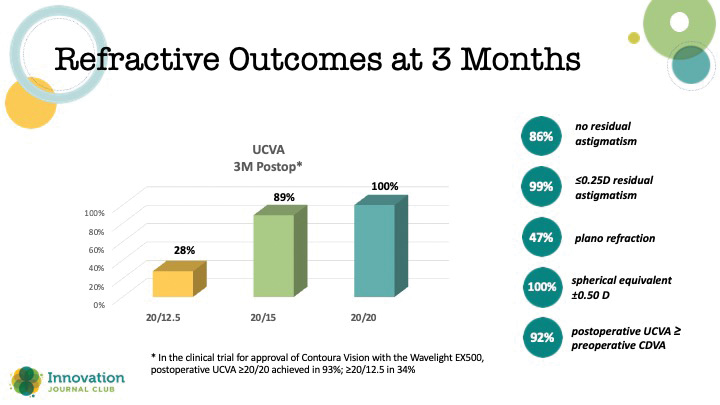Watch the latest episodes of the Innovation Journal Club series on Eyetube.

New software rarely garners much attention. But when that software offers to improve surgical planning and result in more reliable and predictable postoperative refractive outcomes, it may be worth a deeper exploration to understand its impact for clinical practice. In episode 5 of Innovation Journal Club, I. Paul Singh, MD, interviewed Mark Lobanoff, MD, about two software development projects he is involved in.
Topography-Guided LASIK
According to Dr. Lobanoff, the release of topography-guided LASIK with Contoura (Alcon) was a game-changer in refractive surgery, conceptually offering the most accurate way to achieve a smooth, aspheric cornea. As he started to perform treatments, Dr. Lobanoff said he was generally pleased with outcomes but sensed there was room for improvement.
The fundamental issue Dr. Lobanoff identified with topography-guided LASIK is that treatment is planned based on the manifest refraction. Yet, each cornea has its own unique topographic pattern, with each peak and valley effectively creating a higher-order aberration (HOA) that affects the refraction of light. Manifest refraction considers the whole effect of HOAs but cannot discern the effects of each individual contour. In short, once any peak or valley is corrected, the manifest refraction theoretically changes as well.
“When you correct the topography, when you correct these hills and valleys on the cornea, the cornea that was in the phoropter that gave you that manifest refraction, it doesn’t exist anymore. When you’ve taken this mountain and you’ve reduced it, it’s a different cornea than what produced your manifest refraction. We needed a different way to calculate these treatments,” Dr. Lobanoff said.
Dr. Lobanoff’s proposed solution is the Phorcides Analytical Engine (PAE), an analytical engine to assist with Contoura LASIK treatment planning. By adapting to the cornea measurement principles used in the topographic analysis of the earth, the PAE provides a way to determine the actual low-order treatment astigmatism magnitude and axis. Briefly, the Phorcides Analytic engine:
- Assigns a refractive vector value to each area of topographic irregularity (called a talus) to calculate “true” low-order anterior corneal astigmatism.
- Incorporates posterior corneal data from a Scheimpflug device to calculate total cornea low-order astigmatism.
- Subtracts anterior and posterior corneal astigmatism from total astigmatism to calculate internal ocular astigmatism.
Clinical and refractive outcomes with Phorcides were assessed in a prospective, single-arm, interventional study at 4 clinics in the United States.1 Outcomes included UCVA and BCVA at 3 months and a patient questionnaire to assess quality of vision. Monocular refractive outcomes at 3 months are shown in the Figure.

Figure. Refractive outcomes in a study assessing the Phorcides Analytical Engine.
For all of the complex mathematical computation that PAE performs, fundamentally, it brings in more data for analysis, including anterior and posterior corneal topography and manifest refraction, and then efficiently presents a treatment option for the surgeon to use or alter.
“It’s done the mathematics for you,” Dr. Lobanoff explained. “It’s done a lot of very complex computational features to it. But at the end of the day, the surgeon has to say, ‘I believe in this.’ They may modify it a little bit. And then they take that final treatment and put in the laser.”
Streamlined Refractive Cataract Surgical Planning
Another surgical software developmental program Dr. Lobanoff is involved with, eyeTELLIGENCE, a refractive cataract surgery planning platform, follows a conceptually similar algorithm as PAE: use more data to produce an improved treatment plan.
At a functional level, eyeTELLIGENCE (being developed in partnership with Baush + Lomb) pulls together data from various diagnostic devices (in a manufacturer-agnostic fashion), as well as pre- and postoperative information from the electronic records. The software also combs through a database built with artificial intelligence software to assess the most accurate IOL power calculation formula to use based on predefined anatomic or clinical characteristics.
“What does an IOL formula do? It gives you mathematical recommendations for this power lens should give you the best result. What we’ve been missing in ophthalmology is software that will tell you here’s the right formula to use,” Dr. Lobanoff said.
According to Dr. Lobanoff, if eyeTELLIGENCE works as expected, it is poised to reduce power calculation errors and thus help further refine postoperative outcomes. Yet it is also a platform upon which additional features can be integrated to reduce the potential for medical errors and provide the surgeon feedback on completed cases.
“What’s nice about eyeTELLIGENCE too is it also looks at your parameters as well. What’s going to be nice to see is when we start to look back at our data, If we change something in our technique, does that impact our efficiency and outcomes? And you’re going to have ways to look at that too, with eyeTELLIGENCE,” Dr. Singh said.
1. Stulting RD, Lobanoff M, Mann PM 2nd, et al. Clinical and refractive outcomes after topography-guided refractive surgery planned using Phorcides Surgery Planning Software. J Cataract Refract Surg. Published online Feb 10, 2022.


